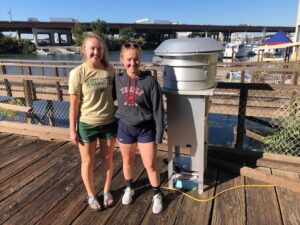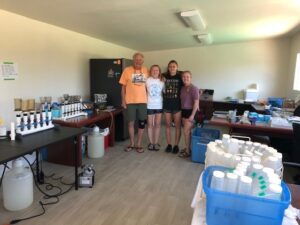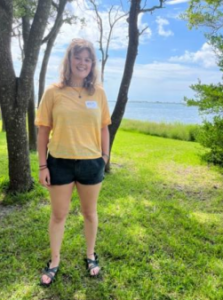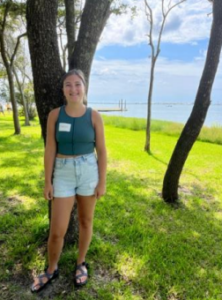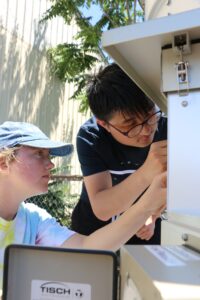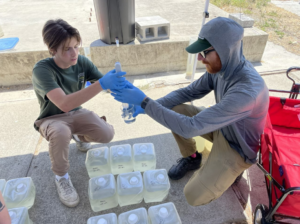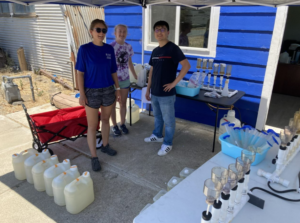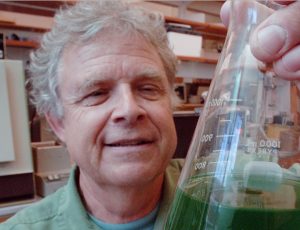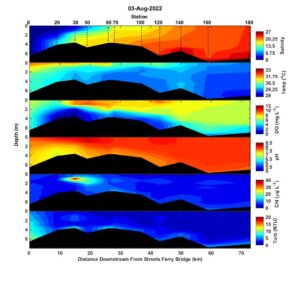
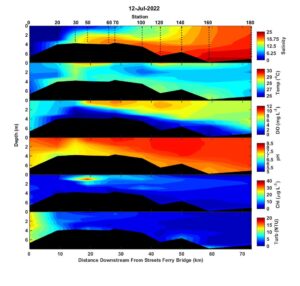
Hi all,
Prior to sampling on July 12, the Neuse basin had some substantial rain and river peaked on July 12 and 13 at about 4 times the seasonal average. On July 12, the main impact seen on the estuary was freshening of the upper estuary where low salinity water <5 extended downstream to stations 60 and 70. On the previous sampling on June 15, surface water salinity at these stations was ~10. High turbidity, 10 -15 NTU also resulted from the high flow. The estuary was stratified from New Bern to the mouth and bottom waters were hypoxic along that distance. As on June 15, there was a small subsurface maximum of chlorophyll a occurred along the pycnocline at stations 30 and 50. Microscopic examination of station 50 surface water showed the dominant organism was the same as on June 15, the dinoflagellate Levanderina fissa.
The high flows of mid July were short lived and there was hardly any rainfall in the basin in the 2 weeks prior to sampling on 3 August. Conditions on August 3 were nearly identical to those on June 15. Surface salinity at station 60 was about 10 and surface salinity at the mouth was greater 20. Bottom water salinity at the mouth exceeded 25. Stratification was strong upstream near New Bern and moderate in the mid and lower estuary. Hypoxic conditions (< 2 mg/L) occurred in the upper estuary from station 20 to 50. The only area of high chlorophyll was the subsurface patch of high biomass that has apparently persisted at stations 30 and 50 all summer. The sample was again dominated by the dinoflagellate Levanderina fissa but it also contained a diverse mix of diatoms, cryptophytes, chlorophytes, and other dinoflagellates. None of the mixed assemblage are known to be problematic with regard to toxins and fish kills.
I hope everyone enjoys the rest of the summer and stays cool.
Best regards,
Nathan
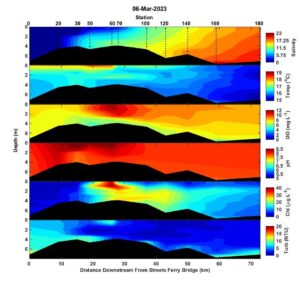


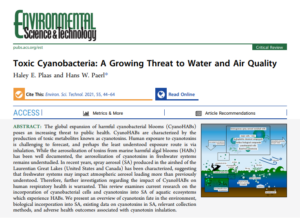
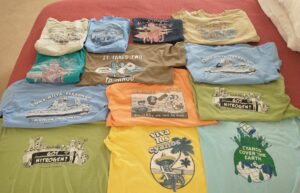
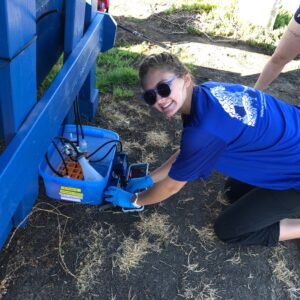 The Paerl Lab was back in the Bay Delta, CA last week! Hans Paerl, Leah Nelson, Alex Sabo, and Haley Plaas were working to continue Haley’s dissertation research which focuses on assessing the linkage between nutrient enrichment, phytoplankton community composition, cyanobacterial harmful algal bloom toxin production, and aerosol formation in the Sacramento-San Joaquin River/Bay Delta estuarine ecosystem. This research was accomplished by completing a combination of aerosol measurements and a nutrient addition bioassay experiment. For this trip, an additional nutrient was added to the bioassay: NH4 and NH4 + P! We will be sure to keep you updated as we analyze the data from these experiments.
The Paerl Lab was back in the Bay Delta, CA last week! Hans Paerl, Leah Nelson, Alex Sabo, and Haley Plaas were working to continue Haley’s dissertation research which focuses on assessing the linkage between nutrient enrichment, phytoplankton community composition, cyanobacterial harmful algal bloom toxin production, and aerosol formation in the Sacramento-San Joaquin River/Bay Delta estuarine ecosystem. This research was accomplished by completing a combination of aerosol measurements and a nutrient addition bioassay experiment. For this trip, an additional nutrient was added to the bioassay: NH4 and NH4 + P! We will be sure to keep you updated as we analyze the data from these experiments.